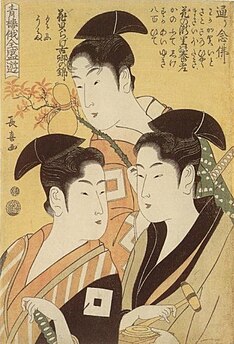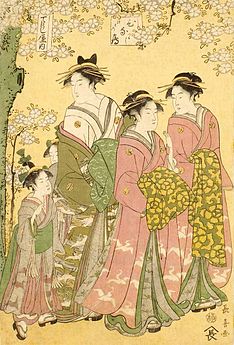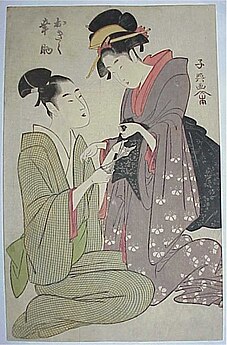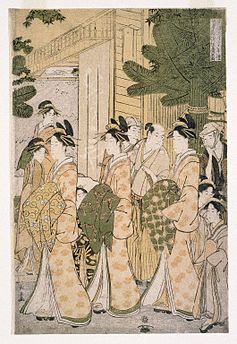Eishōsai Chōki

Eishōsai Chōki (Japanese: 栄松斎 長喜), also known as Momokawa Chōki, was a designer of ukiyo-e style Japanese woodblock prints who was active from about 1786 to 1808. He, along with Utamaro, was a pupil of Toriyama Sekien (1712–1788). Chōki is best known for his pictures of beautiful slender women (bijin-ga), often with atmospheric backgrounds.
The artist signed most of his works Chōki (長喜), he also signed some work Eishōsai (栄松斎) or Shikō (子興).
Life and career
The details of Chōki's life are obscure. He was likely a student—and possibly an adopted son—of Toriyama Sekien. Chōki specialized in depicting beautiful women and had a number of art names: works signed Chōki were in the style similar to that of Kiyonaga, and those signed Shikō that of Utamaro.[1]
Chōki lived in the home of publisher Tsutaya Jūzaburō, who published several of Chōki's print series. Amongst Chōki's more popular series were the Eight Views of Lake Ōmi (Ōmi hakkei) and the Eight Views of the Treasury of Loyal Retainers (Chūshingura hakkei). He also produced hashira-e pillar prints, kachō-e prints of birds and flowers, and book illustrations. His last known work is the illustrations for the book Nakoso Gate (Nakoso no seki) by Kanwatei Onitake in 1809.[1]
Gallery
- Works by Eishōsai Chōki
-
 Most Splendid Entertainment of the Niwaka Festival in the Licensed Quarters
Most Splendid Entertainment of the Niwaka Festival in the Licensed Quarters -
 The Courtesan Tsuruno-o of the Tsuruya Brothel with her Attendants c. 1795–1801
The Courtesan Tsuruno-o of the Tsuruya Brothel with her Attendants c. 1795–1801 -
 The Courtesan Hinazuru of the Chojiya Brothel with her Kamuro Tsuruji and Tsuruno and Two Unidentified Shinzo
The Courtesan Hinazuru of the Chojiya Brothel with her Kamuro Tsuruji and Tsuruno and Two Unidentified Shinzo -
 Cat's Cradle
Cat's Cradle -
 New Years Parade of the Beauties of the Green Houses
New Years Parade of the Beauties of the Green Houses -
 The artist's signature: "Chōki ga" (left) and "Shikō hitsu" (right)
The artist's signature: "Chōki ga" (left) and "Shikō hitsu" (right)
References
- ^ a b Marks 2012, p. 82.
Works cited
- Marks, Andreas (2012). Japanese Woodblock Prints: Artists, Publishers and Masterworks: 1680–1900. Tuttle Publishing. ISBN 978-1-4629-0599-7.
Further reading
- Hiller, Jack (1960) "Choki: What is a Minor Artist?". In: The Japanese Print: A New Approach, Rutland, Tuttle. 94–101.
- Lane, Richard. (1978). Images from the Floating World, The Japanese Print. Oxford: Oxford University Press. ISBN 9780192114471; OCLC 5246796
- Newland, Amy Reigle. (2005). Hotei Encyclopedia of Japanese Woodblock Prints. Amsterdam: Hotei. ISBN 9789074822657; OCLC 61666175
- Roberts, Laurance P. (1976). A Dictionary of Japanese Artists. New York: Weatherhill. ISBN 9780834801134; OCLC 2005932
External links
 Media related to Eishōsai Chōki at Wikimedia Commons
Media related to Eishōsai Chōki at Wikimedia Commons
- v
- t
- e
- Ukiyo-e
- Japanese woodblock printing
- List of ukiyo-e terms

of 17–19th centuries
- Asayama school
- Eishi school
- Furuyama school
- Harukawa Eizan school
- Harunobu school
- Hasegawa school
- Hishikawa school
- Hokusai school
- Ippitsusai Bunchō school
- Ishikawa Toyonobu school
- Kaigetsudō school
- Katsukawa school
- Kawamata school
- Keisai Eisen school
- Kitagawa school
- Kitagawa Utamaro
- Tsukimaro
- Eishōsai Chōki
- Kitao school
- Miyagawa school
- Nishikawa school
- Nishimura school
- Okumura school
- Ōoka school
- Osaka school
- Ryūkōsai school
- Shigenobu school
- Shunkōsai Fukushū school
- Torii school
- Toyohara school
- Utagawa school
- Utagawa Toyoharu
- Utagawa Toyohiro
- Utagawa Toyokuni I
- Utagawa Kunimasa
- Utagawa Kunisada
- Utagawa Kunisada II
- Utagawa Kunisada III
- Utagawa Sadahide
- Utagawa Kunimasu I
- Utagawa Toyokuni II
- Utagawa Kuniyasu
- Utagawa Kuniyoshi
- Ryusai Shigeharu
- Utagawa Yoshitsuya
- Utagawa Yoshitora
- Kawanabe Kyōsai
- Utagawa Yoshiiku
- Utagawa Yoshitoshi
- Utagawa Yoshifuji
- Utagawa Yoshifusa
- Utagawa Kuniteru I
- Utagawa Hiroshige
- Utagawa Hiroshige II
- Utagawa Hiroshige III
- Utagawa Hirokage
- Utagawa Sadafusa
- Adachi Ginkō
- List of Utagawa school members
- Not associated with any school
artists and movements
- Shin-hanga
- Sosaku-hanga
- Azechi Umetarō
- Eiichi Kotozuka
- Un'ichi Hiratsuka
- Itow Takumi
- Kitaoka Fumio
- Yasuhide Kobashi
- Sakuichi Fukazawa
- Masao Maeda
- Senpan Maekawa
- Maki Haku
- Matsubara Naoko
- Yoshitoshi Mori
- Shikō Munakata
- Tetsuya Noda
- Gihachiro Okuyama
- Kōshirō Onchi
- Kiichi Okamoto
- Saitō Kiyoshi
- Sekino Jun'ichirō
- Toko Shinoda
- Hiroyuki Tajima
- Sadao Watanabe
- Kanae Yamamoto
- Shōzaburō Watanabe
- Hodaka Yoshida
- Tōshi Yoshida
- Suwa Kanenori
- Fujimori Shizuo
- Reika Iwami
- Tadashige Ono
- Chosei Kawakami
- Others
- Kohno Michisei
- Tadashi Nakayama
- Fujio Yoshida
- Japanese painting
- Rinpa school
- Kanō school
- Akita ranga
- Hara school
- Hasegawa school
- Kyoto school
- Nanpin school
- Nanga
- Nihonga
- Shijō school
- Mochizuki school
- Yōga
- Ukiyo-e influenced non-Japanese art
- Japonisme
- Japonaiserie (Van Gogh)
- Impressionism
- Anglo-Japanese style
- Post-impressionism
- Art Nouveau
- Ligne claire






















